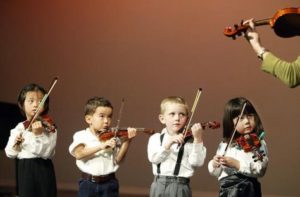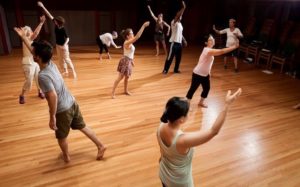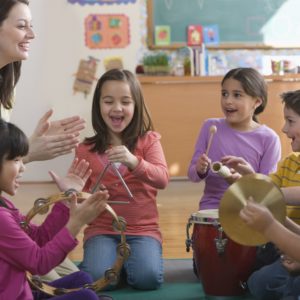A Complete Approach to Learning Music
 Whole Body Learning (WBL) or kinaesthetic learning is a way of teaching and learning music which engages body, mind and emotions, drawing on the principles and approaches of early 20th-century educators such as Orff, Kodály, Dalcroze, Montessori and Suzuki, as well as current research into neuroscience and how the brain learns. The purpose of WBL is to help children extend and develop skills beyond just playing their instrument: these skills include playing by ear, singing, rhythm, harmony, movement and dance, improvisation, and general development of their creativity.
Whole Body Learning (WBL) or kinaesthetic learning is a way of teaching and learning music which engages body, mind and emotions, drawing on the principles and approaches of early 20th-century educators such as Orff, Kodály, Dalcroze, Montessori and Suzuki, as well as current research into neuroscience and how the brain learns. The purpose of WBL is to help children extend and develop skills beyond just playing their instrument: these skills include playing by ear, singing, rhythm, harmony, movement and dance, improvisation, and general development of their creativity.

Dalcroze Eurhythmics
In some ways, WBL harks back to the way music was taught in the era before the advent of readily available printed sheet music. Before the 19th century, music was taught by ear, passing on tunes, melodies, harmonies and rhythms through listening, movement and dance. The industrial production of inexpensive paper in the 19th century meant music could be printed and distributed more widely and this led to a more formalised way of teaching music in which the student was required to read and learn the notes on the page in order to play the music. By the end of the century, this rigid method of teaching had become set in stone, and remains with us today; yet for very young children in particular, whose reading ability is limited, learning music in this way can be extremely arduous – and also boring.
In the early 20th century, educators and pedagogues such as Emile Jacques Dalcroze, Zoltán Kodály and Shinichi Suzuki began to explore ways of teaching music which engaged both body and mind, liberating teacher and student from the rigid method of teaching using printed music. Instead, ideas, concepts and processes could be expressed through creative movements and sound. These methods also foster music appreciation, ear-training, and improvisation while improving musical abilities; in Dalcroze, for example, students listen to the rhythm of a music piece and then express what they hear through movement. These WBL methods also allow students to be taught in a group setting which increases confidence, improves the ability to sense and understand music, and develops auditory memory, communication, expression, and creativity – all significant skills for the musician, especially since music making is an inherently creative activity.
Kodály: Capriccio for Solo Cello (Maria Kliegel, cello)
“Movement anchors thought.” – Carla Hannaford, neuroscientist
Research into neuroscience and how the brain learns demonstrates that learning is easier, faster and more long-lasting if it involves the body as well as the mind. This is because the cerebellum, the part of the brain is the same part of the brain that processes learning, is the area of the brain most associated with motor control as well as memory, attention and spatial perception.
 Because of the way the brain learns, WBL is effective in strengthening learning, improving memory, attainment and retrieval, enhancing motivation, and building confidence and self-esteem. And by letting children, and indeed adults, experience music through their bodies, they make deeper emotional and kinaesthetic connections to it. For the teacher, explaining more abstract aspects of music and music theory may be simplified and clarified through the use of movement, while listening and singing will help in the understanding of melody and harmony.
Because of the way the brain learns, WBL is effective in strengthening learning, improving memory, attainment and retrieval, enhancing motivation, and building confidence and self-esteem. And by letting children, and indeed adults, experience music through their bodies, they make deeper emotional and kinaesthetic connections to it. For the teacher, explaining more abstract aspects of music and music theory may be simplified and clarified through the use of movement, while listening and singing will help in the understanding of melody and harmony.
WBL can be used to teach children from a very young age because between the ages of 4 and 8 a child’s aural development and learning is at its highest; it is also the time when a child’s language capacity and accent is cemented, and because music is also language, children who initially learn music through listening, playing by ear, singing and dance tend to develop very good pitch, and even perfect pitch, and strong rhythmic awareness.
WBL gives students, especially very young students, a framework for learning which is fun and educational, and offers teachers a method, or combination of methods, which bring entertainment and excitement to lessons through simple, creative activities.



